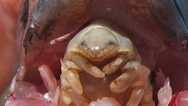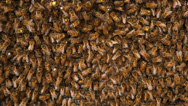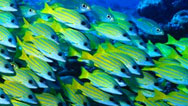Slime Mold Smarts
- By Anna Rothschild and Ferris Jabr
- Posted 11.08.12
- NOVA scienceNOW
The slime mold Physarum polycephalum is a single cell without a brain, yet it can make surprisingly complicated decisions. In this animated video short, watch as a slime mold navigates through a maze and solves a civil engineering problem.
Learn more about slime molds at Scientific American.
Transcript
Slime Mold Smarts
Posted: November 8, 2012
Narrator: Meet the slime mold Physarum polycephalum. It looks kind of like a fungus, but it's actually a single celled life-form known as a protist. The thing about Physarum is that it doesn't have a brain or even a nervous system. But nevertheless, it can make surprisingly sophisticated decisions.
For example, slime molds can find the shortest route through a maze towards a piece of food. First, the slime mold extends its tendrils through every corridor, essentially mapping the entire maze. It then retracts every tendril that didn't find food, leaving behind a trail of slime that acts as a kind of external memory. The trail reminds the slime mold that certain corridors are dead ends. It avoids these areas and grows exclusively along the shortest path from the beginning of the maze to the tasty treat.
But that's not all. After scientists placed food in the relative position of major cities and urban areas, slime molds accurately recreated the rail system of Tokyo, and the major roadways of England, Canada, Spain, and Portugal. In other words, this one cell solved a real world problem that it took teams of engineers to figure out.
This might not sound like rocket science, but these experiments are just the beginning: researchers are discovering more examples of Physarum's slimy smarts all the time. And this single-celled organism is proving that complex decision making doesn't require a big brain. In fact, it doesn't require a brain at all.
Credits
PRODUCTION CREDITS
- Produced for NOVA and Scientific American
- by Anna Rothschild and Ferris Jabr
- Written by
- Anna Rothschild and Ferris Jabr
- Animated and Edited by
- Anna Rothschild
- Production Help from
- Allison Eck
- Original Footage
- © WGBH Educational Foundation 2012
MEDIA CREDITS
- (Trans-Canadian Slimeways video)
- Courtesy Professor Andrew Adamatzky, UWE, Bristol
- (slime in petri dish)
- Courtesy Audrey Dussutour
IMAGE
- (main image: slime in petri dish)
- Courtesy Audrey Dussutour
Related Links
-

What Are Animals Thinking?
Probe animal morality, the "swarm intelligence" of a beehive, the amazing navigation talents of pigeons, and more.
-

The Tongue-Eating Parasite
Gross science: This parasite crawls into a fish's mouth and replaces its tongue. Enough said.
-

The Waggle Dance
Watch David Pogue shake his money maker like a honeybee.
-

Emergence
How does the "intelligence" of an ant colony or the stock market arise out of the simple actions of its members?



